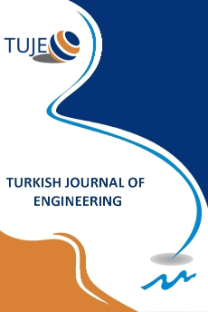The modelling, simulation, and implementation of wireless power transfer for an electric vehicle charging station
The modelling, simulation, and implementation of wireless power transfer for an electric vehicle charging station
Wireless Power Transfer, Electric Vehicle, Charging Station,
___
- Assawaworrarit S & Fan S (2020). Robust and efficient wireless power transfer using a switch-mode implementation of a nonlinear parity–time symmetric circuit. Nature Electronics, 3(5), 273–279.
- Baikova E, Romba L, Valtchev S, Melicio R & Pires V F (2018). Electromagnetic Influence of WPT on Human’s Health. October 2018, 141–161.
- Brown W C (1965). Experimental Airborne Microwave Supported Platform.
- Brown W C (1969). Microwave To DC Converter.
- Chapman S J (2012). Electric Machinery Fundamentals.
- Cheng D K (1983). Field and Wave Electromagnetics.
- Christ A, Douglas M G, Roman J M, Cooper E B, Sample A P, Waters B H, Smith J R & Kuster N (2013). Evaluation of wireless resonant power transfer systems with human electromagnetic exposure limits. IEEE Transactions on Electromagnetic Compatibility, 55(2), 265–274.
- Fawwaz T, Ulaby U R (2015). Fundamentals of applied electrostatics.
- Frechter Y & Kuperman A (2020). Analysis and design of inductive wireless power transfer link for feedback-less power delivery to enclosed compartment. Applied Energy, 278(August), 115743.
- Glaser P (1973). Method and Apparatus for converting solar Radiation to electrical Power. 1–4.
- Imura T & Hori Y (2011). Maximizing air gap and efficiency of magnetic resonant coupling for wireless power transfer using equivalent circuit and Neumann formula. IEEE Transactions on Industrial Electronics, 58(10), 4746–4752.
- Kim J, Seo J, Jung D, Lee T, Ju H, Han J, Kim N, Jeong J, Cho S, Seol J H & Lee J (2020). Active photonic wireless power transfer into live tissues. Proceedings of the National Academy of Sciences of the United States of America, 117(29), 16856–16863.
- Kurs A, Karalis A, Moffatt R, Joannopoulos J D, Fisher P & Soljačić M (2007). Wireless power transfer via strongly coupled magnetic resonances. Science, 317(5834), 83–86.
- Kuzey S (2017). Elektrikli Araç İçin Endüktif Manyetik Bağlı Güç Aktarım Sistemi Tasarımı. Gazi Üniversitesi.
- Kuzey S, Balci S & Altin N (2017). Design and analysis of a wireless power transfer system with alignment errors for electrical vehicle applications. International Journal of Hydrogen Energy, 42(28), 17928–17939.
- Le A, Truong L, Quyen T, Nguyen C & Nguyen M (2020). Wireless Power Transfer Near-field Technologies for Unmanned Aerial Vehicles (UAVs): A Review. EAI Endorsed Transactions on Industrial Networks and Intelligent Systems, 7(22), 162831.
- Lee S H, Yi K P & Kim M Y (2019). 6.78-MHz, 50-W wireless power supply over a 60-cm distance using a GaN-based full-bridge inverter. Energies, 12(3).
- Liu Z, Wang L, Tao C, Li F, Guo Y, Li S & Zhang Y (2021). Receiver Position Identification Method of Wireless Power Transfer System Based on Magnetic Integration Inductance. IEEE Transactions on Industry Applications, 9994(c), 1–1.
- Mahmud M H (2016). Efficient Wireless Power Charging of Electric Vehicle by Modifying the Magnetic Characteristics of the Medium (Issue August).
- Maiman T H (1967). Ruby laser system. 3,353,115.
- Schuder J C (2002). Powering an artificial heart: Birth of the inductively coupled-radio frequency system in 1960. Artificial Organs, 26(11), 909–915.
- Shen S, Kim J & Clerckx B (2021). Closed-Loop Wireless Power Transfer with Adaptive Waveform and Beamforming: Design, Prototype, and Experiment. 1–9.
- Sun L, Ma D & Tang H (2018). A review of recent trends in wireless power transfer technology and its applications in electric vehicle wireless charging. Renewable and Sustainable Energy Reviews, 91(December 2016), 490–503.
- Tesla N (1898). Method of and Apparatus for Controlling Mechanism of Moving Wessels.
- Tesla N (1900a). Apparatus For Transmission of Electrical Energy. In ACM SIGGRAPH Computer Graphics.
- Tesla N (1900b). N. Tesla. System of Transmission of Electrical Energy. 1–6.
- Thrimawithana D J & Madawala U K (2010). A primary side controller for inductive power transfer systems. Proceedings of the IEEE International Conference on Industrial Technology, 661–666.
- Ustun D, Balci S & Sabanci K (2020). A parametric simulation of the wireless power transfer with inductive coupling for electric vehicles, and modelling with artificial bee colony algorithm. Measurement: Journal of the International Measurement Confederation, 150, 107082.
- Wang H, Chau K T, Lee C H T & Jiang C (2021). Wireless Shaded Pole Induction Motor with Half-bridge Inverter and Dual-Frequency Resonant Network. IEEE Transactions on Power Electronics, 8993(c), 1–1.
- Yakala R K, Pramanick S, Nayak D P & Kumar M (2021). Optimization of Circular Coil Design for Wireless Power Transfer System in Electric Vehicle Battery Charging Applications. Transactions of the Indian National Academy of Engineering, 0123456789.
- Yan Z, Yang B, Liu H, Chen C, Waqas M, Mai R & He Z (2020). Efficiency Improvement of Wireless Power Transfer Based on Multitransmitter System. IEEE Transactions on Power Electronics, 35(9), 9011–9023.
- Zhang Y & Zhao Z (2014). Frequency splitting analysis of two-coil resonant wireless power transfer. IEEE Antennas and Wireless Propagation Letters, 13(2), 400–402.
- ISSN: 2587-1366
- Yayın Aralığı: 4
- Başlangıç: 2017
- Yayıncı: Mersin Uüniversitesi
Esra Aslı ÇUBUKÇU, Vahdettin DEMİR, Mehmet Faik SEVİMLİ
Strengthening of fire damaged reinforced beams by using ferro cement
Al AMİN, Shorup TAMAL, A. K. M. Fayzul BARİ, Milan MAZUMDER, Md. Ariful HASAN
Molecular dynamic simulation of uniaxial tension deformation applied to α-Fe nanowire
Sefa KAZANÇ, Canan AKSU CANBAY
Clarifying the impact of climatic parameters on vegetation in Moulvibazar district
Mst. Mahbuba KHATUN, Debajani CHAKRABORTY, Ifterkharul ALAM
Short-term wind power prediction with harmony search algorithm: Belen region
Performance evaluation of model predictive control method for neutral point clamped inverter
Word-based game development on Android with an efficient graphical data structure
Mehmet ÇİÇEK, Mustafa GENÇTÜRK, Selami BALCI, Kadir SABANCI
A low-cost smart home automation for elderly who has Alzheimer’s or age-related memory loss
